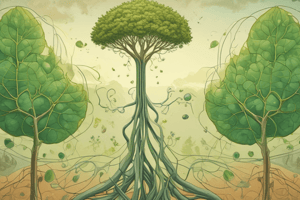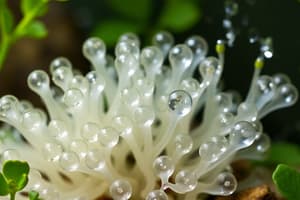Podcast
Questions and Answers
Which factor is most directly responsible for limiting the production of autotrophs when it is in short supply?
Which factor is most directly responsible for limiting the production of autotrophs when it is in short supply?
- Carbon dioxide concentration
- Temperature
- Nutrient availability
- Water availability (correct)
What role do autotrophs play in the ecosystem?
What role do autotrophs play in the ecosystem?
- They are essential as the primary producers in food chains. (correct)
- They are the primary consumers that feed on herbivores.
- They release carbon dioxide as a byproduct of respiration.
- They consume detritus and recycle nutrients back into the soil.
How does temperature affect photosynthesis?
How does temperature affect photosynthesis?
- Photosynthetic enzymes have optimal temperature ranges. (correct)
- Higher temperatures always increase photosynthetic rates.
- Lower temperatures enhance enzyme efficiency.
- Temperature has no impact on photosynthetic activity.
Which of the following is NOT a role of autotrophs in the carbon cycle?
Which of the following is NOT a role of autotrophs in the carbon cycle?
What happens to photosynthetic rates when carbon dioxide levels increase?
What happens to photosynthetic rates when carbon dioxide levels increase?
What is the primary method through which autotrophs produce their food?
What is the primary method through which autotrophs produce their food?
Which organelle is primarily responsible for photosynthesis in autotrophic organisms?
Which organelle is primarily responsible for photosynthesis in autotrophic organisms?
In which environments is chemosynthesis particularly important?
In which environments is chemosynthesis particularly important?
What do light-dependent reactions of photosynthesis primarily produce?
What do light-dependent reactions of photosynthesis primarily produce?
Which of the following processes is a method of autotrophic nutrition involving inorganic compounds?
Which of the following processes is a method of autotrophic nutrition involving inorganic compounds?
What is a key factor that affects the rate of photosynthesis in autotrophs?
What is a key factor that affects the rate of photosynthesis in autotrophs?
Which organism is considered a photoautotroph?
Which organism is considered a photoautotroph?
Flashcards
Photosynthesis rate plateau
Photosynthesis rate plateau
The rate of photosynthesis can remain stable or decrease after reaching a peak, often due to factors like limitations in photosynthetic pigments.
CO2 and photosynthesis
CO2 and photosynthesis
Higher levels of CO2 in the environment generally lead to increased rates of photosynthesis.
Water's role in photosynthesis
Water's role in photosynthesis
Water is absolutely necessary for photosynthesis, and its scarcity can heavily limit the production of autotrophs.
Temperature effect on photosynthesis
Temperature effect on photosynthesis
Signup and view all the flashcards
Nutrients and autotroph production
Nutrients and autotroph production
Signup and view all the flashcards
Autotrophs
Autotrophs
Signup and view all the flashcards
Photosynthesis
Photosynthesis
Signup and view all the flashcards
Chloroplasts
Chloroplasts
Signup and view all the flashcards
Chemosynthesis
Chemosynthesis
Signup and view all the flashcards
Primary producers
Primary producers
Signup and view all the flashcards
Light-dependent reactions
Light-dependent reactions
Signup and view all the flashcards
Light-independent reactions (Calvin cycle)
Light-independent reactions (Calvin cycle)
Signup and view all the flashcards
Heterotrophs
Heterotrophs
Signup and view all the flashcards
Study Notes
Autotrophs
- Autotrophs are organisms that produce their own food using energy from non-biological sources.
- They are the primary producers in ecosystems, forming the base of the food web.
- The primary method for autotrophs to produce food is photosynthesis.
- Photosynthesis converts carbon dioxide and water into sugars (glucose) using sunlight.
- Photosynthesis occurs in chloroplasts, specialized organelles found in plant cells, algae, and some bacteria.
- Chemosynthesis is another method of autotrophic nutrition.
- In chemosynthesis, organisms use energy from chemical reactions (inorganic chemical compounds) to produce food.
- Chemosynthesis supports ecosystems in environments lacking sunlight, such as hydrothermal vents and deep ocean habitats.
Examples of Autotrophs
- Plants are photoautotrophs, using photosynthesis to produce food.
- Algae, aquatic organisms using photosynthesis, include diatoms and kelp.
- Cyanobacteria, photosynthetic bacteria, are often found in aquatic environments and contribute to atmospheric oxygen.
- Some bacteria utilize chemosynthesis, converting inorganic chemicals into usable compounds.
Key Processes in Autotrophic Nutrition
- Photosynthesis: Plants and other organisms use sunlight to synthesize foods from carbon dioxide and water.
- Light-dependent reactions: Capture light energy into chemical energy (ATP and NADPH). These reactions occur in thylakoid membranes of chloroplasts.
- Light-independent reactions (Calvin cycle): Use ATP and NADPH to fix atmospheric CO2 and synthesize organic molecules like glucose.
- Chemosynthesis: Certain bacteria use chemical energy to synthesize organic compounds from inorganic substances, crucial in ecosystems lacking sunlight.
Factors Affecting Autotroph Production
- Sunlight intensity: Photosynthesis rates increase with light intensity up to a point, then may remain constant or decrease due to pigment saturation.
- Carbon dioxide concentration: Higher CO2 levels generally boost photosynthetic rates.
- Water availability: Essential reactant in photosynthesis, affecting autotroph production with limited availability.
- Temperature: Photosynthetic enzymes operate within an optimal temperature range; extreme temperatures inhibit activity.
- Nutrients: Essential nutrients like nitrogen and phosphorus influence autotroph growth and production.
Importance of Autotrophs
- Primary producers: Essential to food chains and webs, forming the foundation for other organisms' food and energy sources in an ecosystem.
- Oxygen production: Photosynthetic organisms release oxygen, crucial for aerobic respiration in most organisms.
- Carbon cycling: Autotrophs absorb CO2, playing a role in the global carbon cycle.
- Ecosystem stability: Healthy autotroph populations are vital for maintaining ecosystem health and stability.
Studying That Suits You
Use AI to generate personalized quizzes and flashcards to suit your learning preferences.
Description
This quiz explores the fascinating world of autotrophs, the organisms that produce their own food through processes like photosynthesis and chemosynthesis. You'll learn about different types of autotrophs, their roles in food webs, and the environments they thrive in. Test your knowledge on how these vital organisms sustain ecosystems.



